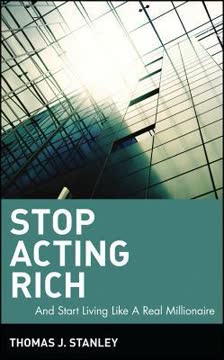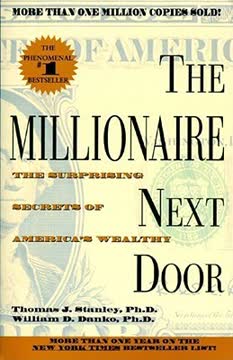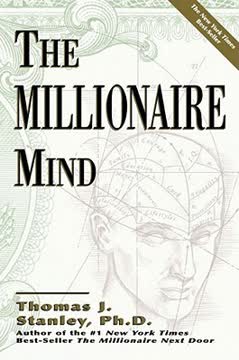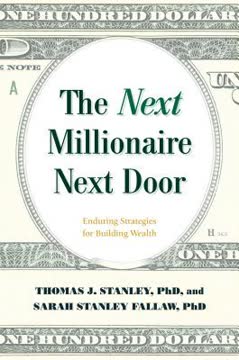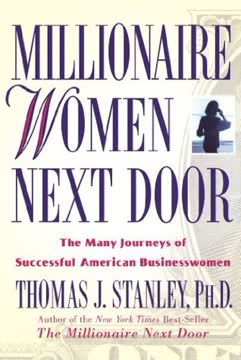Key Takeaways
1. Being Rich vs. Acting Rich: A Matter of Lifestyle
Most people who act rich are not rich!
Looking vs. Being. The book distinguishes between those who "act rich" by displaying expensive items and those who are "actually rich" through wealth accumulation. Many people prioritize appearances over financial security, leading to a cycle of debt and financial instability.
Aspirational Spending. "Aspirationals" often mimic the behaviors of the "glittering rich," but lack the income to sustain such a lifestyle. They focus on status symbols like homes, cars, and clothing, while neglecting savings and investments. For example, they may lease a luxury car but stiff the caddy at the golf course.
True Wealth. Real millionaires often live below their means, prioritizing financial independence over conspicuous consumption. They focus on building wealth through saving, investing, and financial planning, rather than trying to look wealthy.
2. Challenging Common Misconceptions About Wealth
Most people who act rich are not rich!
Dispelling Myths. The book challenges common misconceptions about the wealthy, revealing that many millionaires don't live in upscale neighborhoods, drive expensive cars, or wear designer clothes. Instead, they prioritize frugality and financial discipline.
Statistics Don't Lie. Despite significant income generated by U.S. households, only a small percentage achieve millionaire status. Many people spend their income on depreciating assets and luxury items, rather than investing for the future.
The True Measure. The book emphasizes that true wealth is measured by investments and liquid assets, not by the value of one's home or possessions. "Embellished net worth," which includes home equity, can be misleading due to market fluctuations.
3. The Pitfalls of Emulating the Glittering Rich
They matter because they are rich, and they act rich...They really matter to us because, sadly, we have become a society that seeks to emulate their consumption lifestyle to the detriment of our financial health.
The Allure of Luxury. The "glittering rich" are a small minority who can afford a high-consumption lifestyle without compromising their wealth. However, society often seeks to emulate their spending habits, leading to financial strain for those who cannot afford it.
Marketing's Influence. Marketers and advertisers contribute to the problem by promoting the idea that luxury goods are badges of success. This creates a culture of hyperconsumerism, where people feel pressured to buy expensive items to project a certain image.
The Illusion of Success. Many people believe that owning luxury items will enhance their overall satisfaction with life. However, research suggests that happiness is more closely linked to experiences, relationships, and financial security than to material possessions.
4. The Wealth Equation: A True Measure of Affluence
Simply stated, your net worth [augmented] should equal 10 percent of your age times your annual realized household income (0.10 age income expected net worth).
Defining Affluence. The book introduces the "Wealth Equation" as a way to determine whether someone is truly affluent based on their age, income, and net worth. This equation helps distinguish between those who are genuinely wealthy and those who are merely high-income earners.
Wealth Index (WX). The Wealth Index (WX) is the ratio of actual net worth to expected net worth, as calculated by the Wealth Equation. Those with a high WX are considered "balance sheet affluent" (BA), while those with a low WX are "income statement affluent" (IA).
Playing Offense vs. Defense. BAs become wealthy by playing great defense: living below their means, saving, and investing wisely. IAs become wealthy by playing excellent offense: generating high incomes, but often hyperconsume. The BAs are much more efficient in converting income into wealth.
5. The Influence of Upbringing on Financial Habits
Among the least important were luck, investing in the stock market, and having high academic achievement.
Early Socialization. The book emphasizes the importance of early financial education and socialization. Those who grew up in frugal households with parents who taught them how to invest and manage money are more likely to become wealthy.
Avoiding the Comparison Trap. Parents who purposely avoid living in expensive homes situated in neighborhoods that would constantly remind them that they have financial difficulty living in this environment are more likely to raise children who become wealthy.
Teaching Financial Literacy. Parents should teach their children that true quality is not determined by what can be purchased and that those who dress and drive as if they are rich are not always wealthy. They should also emphasize the importance of investing and managing money effectively.
6. Occupational Choices and Wealth Accumulation
Money, he said with a wave of his hand, is the most easily renewable resource.
Occupational Status vs. Net Worth. The book reveals that high occupational status does not always translate into high net worth. Some high-status professions, such as physicians and attorneys, are prone to high incomes but low wealth accumulation due to high consumption lifestyles.
The Frugal Professions. Occupations like engineers and educators often have higher wealth indices than high-status professions. This is because they tend to be more frugal, investment-oriented, and less concerned with displaying wealth.
Location Matters. The book highlights that mining engineers, who often live in small towns with lower costs of living, are among the most productive in transforming income into wealth. This is because they are less exposed to the temptations of hyperconsumerism.
7. The High Cost of High-Status Consumption
If you live in a pricey home in an exclusive community, you will spend more than you should and your ability to save and build wealth will be compromised.
The Neighborhood Effect. The book emphasizes that the home and neighborhood environment has a significant impact on wealth accumulation. Living in a pricey home in an exclusive community can lead to increased spending and decreased savings.
The True Cost of Living. The true cost of living in certain homes and neighborhoods is unseen but devastating. The more affluent the neighborhood, the more its residents spend on almost every conceivable product and service.
The Millionaire's Choice. Most millionaires do not live in homes that have a market value of $1 million or more. They understand that living in a luxury house also means buying a luxury lifestyle, which can compromise their ability to build wealth.
8. The Elusive Connection Between Spending and Happiness
People are made happier by experiences than by things.
The Myth of Materialism. The book challenges the notion that increased spending leads to greater happiness. In reality, those who spend below their means and focus on building wealth tend to be more satisfied with life.
The Experience Factor. Research suggests that experiences, such as vacations and social interactions, bring more happiness than material possessions. These experiences enhance relationships and create lasting memories.
The Value of Time. Millionaires value their time and allocate their resources accordingly. They prioritize experiences and activities that bring them joy and fulfillment, rather than accumulating expensive items.
9. The Car You Drive Doesn't Define Your Destination
There is no significant correlation between the make [brand] of motor vehicle you drive and your level of happiness with life.
The Auto Myth. The book debunks the myth that successful people drive prestige cars. Many millionaires drive "common" makes of motor vehicles, such as Toyota and Honda, because they prioritize value and reliability over status.
The Security Guard Test. The book shares a story about a physician who was denied access to a parking lot because he drove a Honda. This illustrates how society often judges people based on their car, rather than their achievements.
The Real Drivers. The book reveals that the majority of luxury cars are driven by non-millionaires. This suggests that many people are prioritizing appearances over financial security.
10. The Importance of Financial Independence Over Conspicuous Consumption
Those who think that acting rich must be predicated on hyperconsumption are likely to end up on the short side of both the wealth and the happiness scales.
The True Goal. The book emphasizes that the true goal should be financial independence, not conspicuous consumption. Financial independence provides freedom, security, and control over one's life.
The Trade-Off. Many people sacrifice financial security in order to maintain a high-consumption lifestyle. They may live in expensive homes, drive luxury cars, and wear designer clothes, but they lack the resources to pay for retirement, healthcare, or emergencies.
The Millionaire Mindset. The book encourages readers to adopt the values and lifestyles of self-made millionaires, who prioritize frugality, planning, and investing. By doing so, they can achieve financial independence and enjoy a more fulfilling life.
Last updated:
FAQ
What’s [Stop Acting Rich] by Thomas J. Stanley about?
- Core message: The book distinguishes between truly being rich and merely acting rich, focusing on how real millionaires build wealth versus how many people try to appear wealthy.
- Wealth vs. appearance: Stanley uses research to show that most millionaires live below their means, invest wisely, and avoid conspicuous consumption.
- Purpose: The goal is to help readers break the cycle of overspending and adopt habits that lead to genuine financial independence and satisfaction.
Why should I read [Stop Acting Rich] by Thomas J. Stanley?
- Myth-busting insights: The book debunks common misconceptions about wealth, showing that high income does not necessarily mean high net worth.
- Practical advice: Readers gain actionable strategies for building wealth by living below their means and resisting the lure of luxury brands.
- Happiness connection: Stanley links financial independence with greater life satisfaction, arguing that true happiness comes from prudent money management, not status symbols.
What are the key takeaways of [Stop Acting Rich] by Thomas J. Stanley?
- Frugality among millionaires: Most millionaires live in modest homes, drive practical cars, and avoid flashy spending.
- Income vs. wealth: High earners are not always wealthy; overspending can prevent wealth accumulation.
- Happiness and wealth: Financial independence and prudent spending habits are more closely tied to happiness than luxury consumption.
- Marketing influence: Emotional conditioning and advertising often drive people to buy prestige brands for status, not quality.
What is the difference between being rich and acting rich in [Stop Acting Rich] by Thomas J. Stanley?
- Acting rich: Involves spending lavishly on luxury goods and brands to appear wealthy, often through debt or leasing.
- Being rich: Means having financial independence, living below your means, and accumulating wealth through saving and investing.
- Consequences: Acting rich leads to financial insecurity and dissatisfaction, while being rich brings control and happiness.
What is the Wealth Equation in [Stop Acting Rich] by Thomas J. Stanley and how does it work?
- Definition: The Wealth Equation is 0.10 × age × annual realized household income, estimating expected net worth.
- Purpose: It helps individuals assess whether they are accumulating wealth appropriately for their age and income.
- Wealth Index: By dividing actual net worth by expected net worth, Stanley classifies people as Balance Sheet Affluent (BA) or Income Statement Affluent (IA).
Who are the Balance Sheet Affluent (BA) and Income Statement Affluent (IA) in [Stop Acting Rich] by Thomas J. Stanley?
- Balance Sheet Affluent (BA): These individuals live below their means, save and invest diligently, and have a wealth index above 1.
- Income Statement Affluent (IA): High earners who spend lavishly, resulting in a wealth index below 1 and less accumulated wealth.
- Key difference: BAs focus on building wealth through frugality and planning, while IAs prioritize income and often overspend.
How does [Stop Acting Rich] by Thomas J. Stanley explain the role of consumption and status symbols in wealth building?
- Marketing tactics: Marketers create a false link between luxury consumption and happiness or success.
- Status symbols: Many buy expensive items to signal wealth, but most millionaires prefer quality, moderately priced goods.
- Happiness factor: True satisfaction comes from financial security and living below your means, not from owning status symbols.
What is the “classical conditioning” concept in [Stop Acting Rich] by Thomas J. Stanley and how does it affect spending?
- Definition: Classical conditioning is when people associate brands with admired wealthy individuals, leading to emotional attachment.
- Marketing use: Advertisers exploit this by linking prestige brands with images of success and beauty.
- Spending impact: This psychological effect drives consumers to buy for status rather than quality or personal preference.
What does [Stop Acting Rich] by Thomas J. Stanley reveal about housing choices and their impact on wealth?
- Housing cost impact: Expensive homes in upscale neighborhoods often lead to overspending and reduced savings.
- Millionaire housing data: Most millionaires live in homes valued under $300,000, and there are more millionaires in modest homes than in luxury ones.
- Advice: Stanley recommends buying a home worth less than three times your annual income to maximize wealth-building potential.
How does [Stop Acting Rich] by Thomas J. Stanley address cars and their role in wealth and happiness?
- No happiness link: The make or price of a car does not correlate with life satisfaction.
- Practical choices: Millionaires often drive reliable, practical cars like Toyotas or Hondas rather than luxury brands.
- Status trap: Many who lease or buy expensive cars do so for status, but this does not equate to wealth or happiness.
What does [Stop Acting Rich] by Thomas J. Stanley say about spending on clothing, watches, and personal appearance?
- Frugality in attire: Most millionaires buy quality clothing at moderate prices, often shopping at outlets or department stores.
- Watch preferences: Seiko is the most popular watch brand among millionaires, with many wearing watches received as gifts.
- Modest appearance: Truly wealthy individuals tend to avoid flashy brands, while those acting rich overspend on appearance.
What practical advice does [Stop Acting Rich] by Thomas J. Stanley offer for building real wealth and happiness?
- Live below your means: Prioritize frugality and avoid social pressures to overspend on luxury goods.
- Invest wisely: Focus on saving and investing rather than spending on status symbols.
- Choose your environment: Live in modest neighborhoods where your income places you among the top earners to reduce pressure and increase wealth-building potential.
- Focus on life satisfaction: Value relationships, health, and meaningful activities over material displays, and be mindful of marketing influences.
Review Summary
Stop Acting Rich challenges perceptions of wealth, revealing that true millionaires often live frugally and below their means. The book emphasizes saving, investing, and avoiding unnecessary luxury spending. Readers found the data-driven approach insightful, though some felt it repetitive. Many appreciated the book's message about finding happiness through financial stability rather than conspicuous consumption. However, some critics found the content similar to Stanley's previous works and overly focused on specific luxury goods.
Download PDF
Download EPUB
.epub digital book format is ideal for reading ebooks on phones, tablets, and e-readers.
